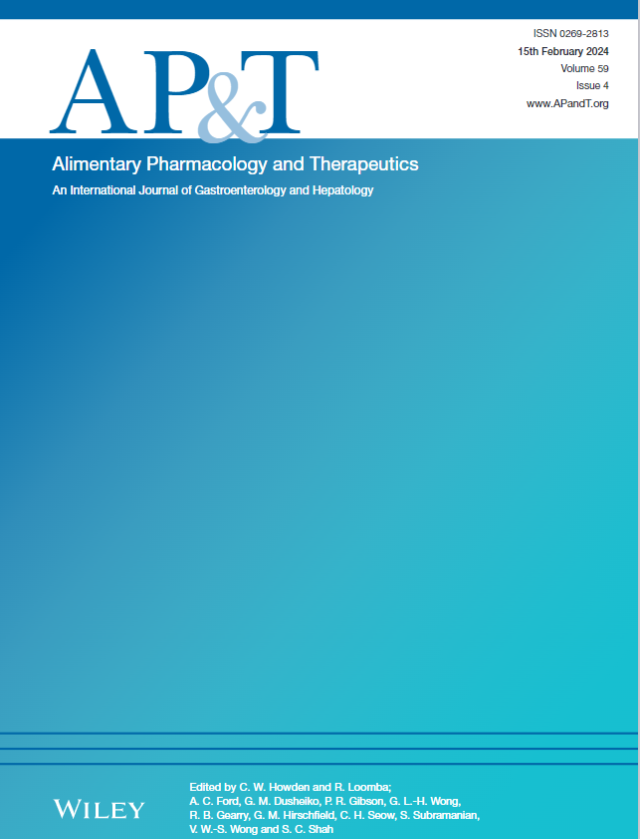炎症性肠病患者疼痛和镇静药物的使用:一项基于全国人群的队列研究
IF 6.7
1区 医学
Q1 GASTROENTEROLOGY & HEPATOLOGY
引用次数: 0
摘要
背景:炎症性肠病(IBD)患者经常经历疼痛、情绪障碍和睡眠中断,这可能导致与普通人群相比更多地使用止痛和镇静药物。这些与死亡率增加、疼痛的矛盾恶化和不适当的IBD治疗中断有关。慢性处方和联合处方增加呼吸抑制、依赖和过量的风险。方法使用临床实践研究数据链,一个具有全国代表性的大型数据集,我们检查了总慢性(bbb90天)阿片类药物的年患病率;2010年1月至2019年12月期间,IBD成人患者服用阿片类药物、加巴喷丁类药物和镇静剂。多变量回归确定了慢性或联合处方的预测因子。结果在17388名患者中,每年有超过20%的患者服用止痛或镇静药物。阿片类药物和加巴喷丁类药物的年患病率分别上升(13.6%-14%和2.5%-5.6%),而镇静剂的年患病率保持稳定(8.4%)。强阿片类药物(3.6%-4.6%)、弱阿片类药物(3.6%-3.7%)和镇静剂(4.2%-4.4%)的慢性处方增加。每年有4.2%至6.9%的人同时服用阿片类药物、加巴喷丁类药物和/或镇静剂。女性、吸烟、诊断时年龄较大、克罗恩病、炎性关节病、肠易激综合征、纤维肌痛或焦虑/抑郁与慢性和/或联合处方阿片类药物或镇静剂显著相关。结论相当比例的IBD患者服用了镇痛和镇静药物,包括长期和联合处方。识别高风险患者对于确保他们优先获得有限的资源至关重要,例如心理治疗,以替代有害的处方。本文章由计算机程序翻译,如有差异,请以英文原文为准。
Pain and Sedative Medication Use Among Individuals With Inflammatory Bowel Disease: A Nationwide Population-Based Cohort Study.
BACKGROUND
Individuals with inflammatory bowel disease (IBD) often experience pain, mood disturbances, and sleep disruption, which may lead to greater use of pain-relieving and sedative medications compared with the general population. These are associated with increased mortality, paradoxical worsening of pain, and inappropriate IBD treatment discontinuation. Chronic prescribing and co-prescribing increase the risk of respiratory depression, dependence, and overdose.
METHODS
Using Clinical Practice Research Datalink, a large nationally representative dataset, we examined the annual prevalence of total, chronic (> 90 days opioids; > 28 days sedatives), and co-prescribed opioids, gabapentinoids and sedatives in adults with incident IBD from January 2010 to December 2019. Multivariable regression identified predictors of chronic or co-prescribing.
RESULTS
Among 17,388 individuals, over 20% were prescribed a pain or sedative medication each year. Annual prevalence for opioids and gabapentinoids increased (13.6%-14% and 2.5%-5.6%, respectively) while sedative prevalence remained stable (8.4%). Chronic prescribing increased for strong opioids (3.6%-4.6%), weak opioids (3.6%-3.7%) and sedatives (4.2%-4.4%). Between 4.2% and 6.9% of individuals per year were co-prescribed opioids, gabapentinoids, and/or sedatives. Female sex, smoking, older age at diagnosis, Crohn's disease, and a diagnosis of inflammatory arthropathy, irritable bowel syndrome, fibromyalgia, or anxiety/depression were significantly associated with chronic and/or co-prescriptions of opioids or sedatives.
CONCLUSION
A substantial proportion of individuals with IBD are prescribed pain and sedative medications, including long-term and co-prescriptions. Identifying high-risk patients is essential to ensure they are prioritised for limited resources, such as psychological therapies, as alternatives to harmful prescriptions.
求助全文
通过发布文献求助,成功后即可免费获取论文全文。
去求助
来源期刊
CiteScore
15.60
自引率
7.90%
发文量
527
审稿时长
3-6 weeks
期刊介绍:
Alimentary Pharmacology & Therapeutics is a global pharmacology journal focused on the impact of drugs on the human gastrointestinal and hepato-biliary systems. It covers a diverse range of topics, often with immediate clinical relevance to its readership.

 求助内容:
求助内容: 应助结果提醒方式:
应助结果提醒方式:


